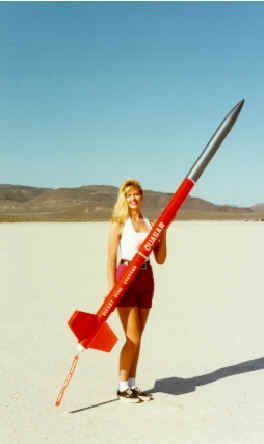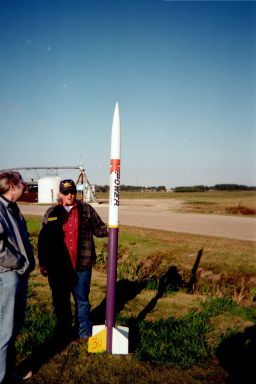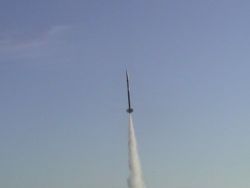| Manufacturer: | Rocket Dynamic Systems  |

Brief:
This kit originally came with a 54mm motor mount, which I swapped for a 76mm
motor mount for use with both commercial and experimental J, K, and L motors.
The airframe was laminated with fiberglass reinforcement and the fins were
mounted to the motor mount with Kevlar®
reinforcements. Due to the weight gain, the 54" Rocket Rage chute that
came with this kit was replaced with dual 80" chutes and a 36" drogue
was added for dual deployment.
Modifications:
The first modification I made to the kit was fiberglass lamination. All of the
airframe components including the couplers, were laminated with one layer of
6oz fiberglass and one layer of 2oz glass. The 2oz was used because the 6oz.
has a rough weave which must be veiled with a finer weave to make finishing the
rocket a much easier chore.
Next, I had to make centering rings that would fit a 3" motor mount into a 4" airframe. I made 5 centering rings for this motor mount modification using my bench mount drill press. While I had the drill press set up for cutting the rings, I also cut bulkheads that fit inside the couplers as well as outside of the couplers.
The fins were laminated to the motor mount with a heavy weave Kevlar®. The Kevlar® went from fin tip to fin tip across the motor mount. One centering ring was mounted aft of the fins and 2 were mounted together in front of the fins. The remaining centering rings were mounted with one 1/4" from the aft end and the other halfway back down the mount towards the forward centering rings.
Since all of the tubes were long, I was able to strategically place components for optimum performance. Point in case: I made the booster with the anti-zipper design, where the coupler is mounted into the top of the booster and the bulkhead is mounted into the outer end of the coupler. Here the recovery attachment points are placed so your booster will not "zipper" and you create room to put really long motors in. In essence, I could fly this rocket on some of the commercially available 30" long M motors.
Construction:
Rocket Dynamic Systems kits are well known for very strong airframe tubing that
has no glassine covering. These are perfect tubes for fiberglass reinforcements
due to the tubes ability to soak in the epoxy resins. The RDS Quasar came with
two 34" long and one 18" long airframe tubes. This kit was supplied
with two 8" long couplers that were also glassine free. They are a little
undersized, so you can laminate them also with fiberglass.
The nose cone supplied for this kit was an R.W.W. Distributors, better known as Public Enemy Rockets, nose cone. This cone is modeled after the PML 4" cone and is superior in quality. Recovery attachment points are reinforced, and there are two 1/8" wide rings around the shoulder of the cone that gives it a great sealing fit. These rings are adjustable for fit by sanding them.
All bulkheads and centering rings are made from 1/4" quality aircraft grade plywood and are laser cut. This kit came with 3 bulkheads, 2 U-bolt recovery attachment points, and 4 centering rings.
The RDS Quasar has a signature look like no other 4" diameter rocket. Besides the long airframe, this kit has enormous fin area. This kit is supplied with 4 large 1/4" thick aircraft grade plywood fins that come pre-beveled.
This kit was also supplied with simple motor retention hardware.

Finishing:
Sanding...need I say more? 86" of fiberglassed airframe and laminated fins
equals a lot of sanding but the end result was very nice. I went through many
paint schemes before I settled on a purple and white with the K-Power logo on
the upper payload section. I also painted one fin yellow to see what sort of a
roll rate this rocket might have.
Flight:
The Quasar's first flight came on November 10, 2003, on an experimental 76mm
2-grain "candy" motor designated as a J557. This flight was short and
sweet as it reached a grand total of 863ft and deployed the drogue. This motor
was not nearly enough to get it up and going. Luckily the with the large fin
area, the rocket flew very stable and slow. One nice thing about this flight
was that you could see everything in operation from drogue deployment to main
ejection. When I look back on the flight, it actually very nice.
The second flight of the Quasar came on July 31, 2004. This time I turned up the Newtons and flew it on a K777 76mm experimental 3-grain "candy" motor. This motor took about 2 or 3 seconds to come up to pressure before the rocket lifted off of the pad and rocketed straight as an arrow to 4,269ft. One noticeable difference in this flight from the first was the roll rate. On the experimental K motor, this rocket started a very rapid spin about 1,000 feet into the flight, which produced fin spin stabilization throughout the rest of the flight. I had a little too much ejection charge in the drogue section, so all of the parachutes deployed at apogee.
 Prepping this rocket
for flight only produces one problem: you need lots of room for 103" of
rocket. As for room, there is enough room for dual 80" main chutes in the
main airframe as well as 30ft of 1" tubular nylon shock cord. The chutes
were protected from the ejection gasses with standard biodegradable roof
insulation (dog barf).
Prepping this rocket
for flight only produces one problem: you need lots of room for 103" of
rocket. As for room, there is enough room for dual 80" main chutes in the
main airframe as well as 30ft of 1" tubular nylon shock cord. The chutes
were protected from the ejection gasses with standard biodegradable roof
insulation (dog barf).
Since there is very little room for motor retention on the Quasar centering ring, I had to get creative and install four 4-40 threaded inserts into the aft ring. This form of retention uses four 4-40 x 1" long socket head cap screws and washers to retain the motor by trapping the motors thrust ring. Both flights have shown no damage or weakening of the retention system.
Recovery:
Since the payload section is 34" long, I had room to really outfit this
rocket with a rugged recovery system using dual 80" main chutes and 30ft
of 1" tubular nylon with room to spare. The 18" long drogue tube area
has plenty of room for 20ft of 1" tubular nylon and a 36" drogue
chute.
On my second flight of the Quasar, I used 1.5 grams of ejection charge instead of the 1 gram I used on the first flight so the mains came out at apogee. Other than that, the deployment system I put in this rocket works top rate.
Summary:
This rocket is a very reasonably priced kit and is a looker on the field and in
flight. It was created using some of the best components out there. This kit
built stock is a very nice level II rocket but it just screams for the
modifications that I put into it.
Flying it on windy days is not recommended. The fin area of this rocket makes it very susceptible to weather cocking.
This kit is made for the experienced rocketeer in mind. There are no real instructions given, just merely hints, like fiberglassing the airframe for larger motors.
Other Reviews
- Rocket Dynamic Systems Quasar By Dennis Cotton
Brief: High power single stage rocket with motor ejection based recovery. Construction: The kit contains 3 body tubes, 2 couplers, 4 pre-beveled birch plywood fins, 2 centering rings, PML nosecone, launch lugs, 1 plywood bulkhead, nylon strap, 2 attachments for strap, 2 quick links, motor retainer, motor tube. I added the optional baffle system and Aero Pack motor retainer and ...
 |
 |
Flights
Sponsored Ads
 |
 |











